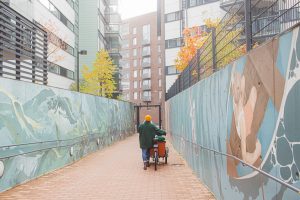A more verdant city plan is being drawn up in Kalasatama: Virtual Verdure brings new tools to support the planning of green infrastructure and opens up opportunities for smart & clean business.
 Intense summer heat that some enjoy and others escape to the water, heavy autumn rains that cause flooding at the railway station and in the indoor car parks of the city centre: the climate crisis will make the conditions in Helsinki more and more varied over the coming years. To increase the flexibility of the urban environment in the changing conditions, we need new kind of planning and the tools to support it.
Intense summer heat that some enjoy and others escape to the water, heavy autumn rains that cause flooding at the railway station and in the indoor car parks of the city centre: the climate crisis will make the conditions in Helsinki more and more varied over the coming years. To increase the flexibility of the urban environment in the changing conditions, we need new kind of planning and the tools to support it.
One important solution is still often neglected: the green infrastructure of cities, i.e. how we bring verdure to the neighbourhoods, streets, yards, roofs and walls. The benefits produced by green infrastructure are called ecosystem services. These include rainwater management, pollination services, wind deflection and recreation, for example. Investing in green infrastructure produces all these different benefits simultaneously, making our cities pleasant, beautiful and healthy.
In the Virtual Verdure project, we support city planners with digitally produced scenarios and innovative infrastructure solutions, i.e. new tools for taking green infrastructure into account in city planning,’ says Project Manager Maija Bergström from the City of Helsinki’s innovation company Forum Virium Helsinki.
From a small local project towards city planning
The goal of the Virtual Verdure project is to draw up a plan for the northern areas of Kalasatama that anticipates new kinds of green infrastructure solutions. This also opens up opportunities for new kind of smart & clean business. The lessons and planning practices of Virtual Verdure will also be available to be utilised in other area development projects in Helsinki in addition to Kalasatama.
The project participants are the City of Helsinki’s innovation company Forum Virium Helsinki, and partner companies WSP and InnoGreen. The project collaborates tightly with Kalasatama area development project, environmental services and city planners of Kalasatama and Western Harbour of the City of Helsinki’s Urban Environment Division.
InnoGreen develops innovative green services that tackle the financial and ecological challenges of the day. As a part of the agile piloting programme in the Kalasatama area, InnoGreen carried out a pilot in 2017, building a prototype rain garden utilising stormwater on a schoolyard. The pilot demonstrated the functionality of the modular structure and also the need to take similar structures into account in the planning of the construction phase.
WSP has been developing a tool for auditing green infrastructure. The tool is used to demonstrate the effect of various green infrastructure solutions on such factors as rainwater management, temperature balancing and the increase of biodiversity and recreational values.
‘Urban greenery produces a great deal of different benefits and values connected to ecology, resident well-being and economic sustainability. It is great that the Kalasatama area construction project can function as a platform to develop these solutions, because this also serves urban development on a larger scale and is in line with the objectives of Carbon neutral Helsinki,’ says Elisa Lähde from WSP.
Learning from the Nordic countries
The project team headed to other Nordic countries to learn from them. For example, Norra Djurgårdstad in Stockholm is an example of an area where nature-based solutions are closely integrated into the planning of the city district. Street trees form green corridors for insects, and rainwater is managed with stormwater streets. The recreational values of the area are improved at the same time. Ambitious green solutions have also been implemented in the areas of Malmö and Copenhagen, which Helsinki can learn from.
In Kalasatama, the aim is to pilot an operating model for how digital technology can help identify the best solutions for taking green infrastructure into account as early as the city planning stage. At the same time, the aim is to develop new kinds of solutions suitable for a dense city, which Finnish companies can take abroad, and create innovations to combat climate change.
‘People need nature for their well-being. By utilising greenery and building smart green solutions, we can create urban environments that support well-being and sustainability. We want to develop the stormwater solutions in cities to be more practical. This kind of a new solution can also make the city greener and more beautiful,’ says Mikko Sonninen, Founding Partner at InnoGreen.
The project participants are the City of Helsinki’s innovation company Forum Virium Helsinki, and partner companies WSP and InnoGreen. The project collaborates tightly with Kalasatama area development project, environmental services and city planners of Kalasatama and Western Harbour of the City of Helsinki’s Urban Environment Division. The project is funded by the Helsinki-Uusimaa Regional Council.


